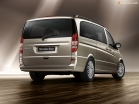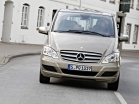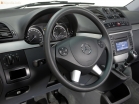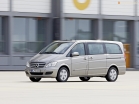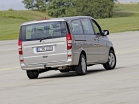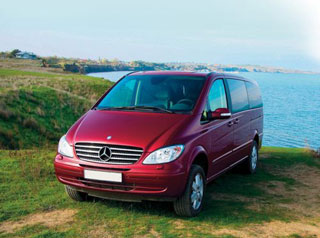Mercedes Benz Viano test drive since 2010 Minivan
A car without a gallery
 The presentation of the mini-wen was not held in Stuttgart, where we showed a promising development a year ago in secret, but in Hamburg. However, the place in this case does not matter much.
The presentation of the mini-wen was not held in Stuttgart, where we showed a promising development a year ago in secret, but in Hamburg. However, the place in this case does not matter much. The atmosphere of Test-Drive was saturated with the pride of Mercedes employees for their new car. I must say, they have something to be proud of. The first real mini-ven company and its first front-wheel drive car were really successful.
The Mercedes-Benz concern again confirmed its commitment to strict forms. This approach for the Germans is not news, the news is different. Mercedes cars are usually called beautiful, sometimes ugly, but pretty - almost never. The novelty is pretty. The creators of the car in vain abandoned the idea of \u200b\u200bassigning her their own name. Instead of a dry, the V-class asks at least the working name Viano. But it seems that the decision of Mercedes -Benz is final. Representatives of the company more than once corrected journalists when someone called the car in the old way.
The car is produced in 4- or 5-door options. The latter has two sliding doors. But this version is intended for the right -wing countries. However, you should not be upset: a sliding side door opens an easy access to the salon and closes quite easily, but the integrity is still more convenient.
According to the dimensions, the new mini-ven does not stand out from a number of classmates. Despite its more than 4.5 m, the car does not look long. Therefore, at first the volume of the cabin is amazing. One of the company’s employees at a press conference said: when we created this car, we did not want to act on the principle-in front is good, in the second row to be tolerant, and you can sit on the third. There is no galley on the V-class. In all ranks the same insanely comfortable chairs. With armrests, many adjustments, pleasant to the touch upholstery.
They are quite tough, but so well worked out that the passenger feels surrounded by surrounded. The middle row can be installed with the back to the movement - such a layout has several advantages. For example, a fairly wide and convenient table can be installed between the rows. In addition, sitting face to face is much more pleasant than looking a companion in the back of the head. Unless, of course, a visual visa is antipathetic to you or you do not rock you when you sit with your back forward.
When we raced on the new mini-wan on a chic German autobahn, I remembered a winter trip on the Mercedes G SUV from Germany to Finland, beyond the polar circle. Honestly, despite the comfortable salon, we are tired then scary. Heavy modern SUVs (we are talking about serial cars), and the G-class is no exception, tend to swing.
They have long and rather soft suspension, which on bad roads conceals all irregularities. Nona normal highways, when the speeds are quite high, the car will swing, which is very tiring with a long trip. This effect is almost completely absent in a heavy V-class. The designers of Mercedes managed to eliminate it by developing a new pneumatic rear suspension. The car behaves, almost like a passenger, and a journey on it will only give pleasure.
Instead of ordinary rear springs, two hollow rubber pillows are on the V-class, which, when asymmetric loading and in corners, are pumped up under the floor of an electric compressor, acting as additional reptile stability stabilizers. At the same time, the rigidity of the shock absorbers changes. This not only retains a given road clearance, but also holds the car from swinging. The greater the load, the more comfort the suspension provides. When there is only one driver in the car and there is no baggage, the car reacts quite noisily to road joints. The design of the rear suspension has positively influenced controllability. It is quite difficult for the designers to achieve a high and heavy mini-wen, as a passenger car. Such a front -wheel drive car should quickly tear the front in the bend and slowly respond to gas discharge. Mercedes does not. It is still unknown how the front-wheel drive passenger Mercedes will behave (there are stubborn rumors that the new C-Class will be a front-wheel drive), but, judging by the new mini-van, we can assume that it is not bad.
The V -class is equipped with three engines - two gasoline 2 liters (it is intended exclusively for Italy) and 2.3 liters and a 2.3 liter diesel engine. Next year, a 6-cylinder engine of 2.8 liters from Volkswagen will appear, which is widely used in the top versions of this company. According to Mercedes designers, it is very well suited for the new mini-wen. If you compare the characteristics of the motors, to be honest, to prefer any of them is quite difficult. The diesel is attractive to its efficiency and a torque of 230 nm in a wide (from 1700 to 2400 rpm) range. But diesel is diesel, it is somewhat noisier, especially at high speeds. The gasoline engine has its advantages - a decent accelerated dynamics for a car of such sizes (14.5 seconds to hundreds), in addition, its maximum speed is almost 20 km/h higher than that of the diesel version. But fuel consumption is 3-4 liters larger.
Cars with manual and automatic boxes were presented for the test. In the first gear lever is made in the form of a joystick. It is very short, so it seemed that it would be difficult to accurately switch the programs. But the fears were in vain. Yes, several times instead of the 5th, the 3rd stuck, but this happens in almost any car that I had not yet used to get used to it. The machine seemed too responsive.
As soon as the gas pedal was a little drunk, he switched to a low gear (of course, if the speed did not correspond to the speed).
Mini -wen is available in three modifications - Trend, Fashion and Ambiente. The latter is the most sophisticated.
With leather chairs, alloy discs, a 9-liter refrigerator, etc. In the list of additional equipment there are a lot of positions: starting from special bicycle mounts and ending with a standard set of office equipment. There is even a small safe that is screwed to the floor on the left under the middle row of seats.
Naturally, seats can be arranged in a variety of combinations or completely dismantled. The volume of the luggage compartment with a folded last row increases from 581 liters to 1344 liters, with the latter and folded by the second - up to 3104 liters and up to 4564 liters - with 2 rear rows removed.
On the habitual for Mercedes, there were no alarm control buttons.
Disconnecting the security system and unlocking the locks now occurs when you click on the button that throws off the key. The immobilizer with an inductive loop remained the same and acts regardless of the alarm.
The cost of a mini-wen V-class ranges from 50 thousand to 60 thousand DM. It is clear that our taxes and duties make such an attractive price to indecent. Sales in most European countries began in mid -September. Mercedes still does not have any intentions to supply mini-ven to the American market. The plant in Spain, where the V-class is made, is able to produce 25 thousand cars a year. And if some readers go to, they are unlikely to regret it.
Savva Simonov
Source: Motor magazine [No. 6/1996]

